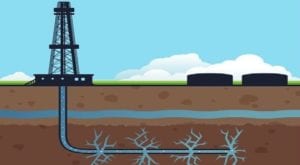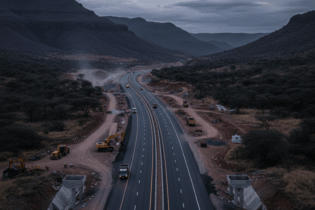Shell’s proposal for hydraulic fracturing or ‘fracking’ in the Karoo has invoked an angry response from local communities. Considering the demand for greener fuel technologies, the issue demands a rational and objective evaluation.
Sidebar: Depleting natural resources There are seven billion people on planet Earth. By 2040, just 28 years from now, the population is expected to be nine billion, or more. It is inevitable that there will be a substantial increase in demand for the world’s natural resources. The BP Statistical Review of World Energy in June 2011 measured total global oil at 188.8 Mt, from proved oil resources at the end of 2010. This is only enough to oil for the next 46.2 years, should global production remain at the current rate, which it will not. Some experts predict that the oil price will escalate to US$225 (R1 848.31) per barrel by 2045,but given the simple rule of supply and demand, it could escalate from today’s US$98 per barrel to as much as US$687 per barrel. A similar picture exists for natural gas, with 2010 measurements showing enough gas in proven reserves to meet 58.6 years of global production. Of all the natural resources, coal as a fossil fuel has the largest reserves, but as China, India and other developing countries continue to increase their appetite for coal, demand could finally outstrip supply. Economic impact In South Africa, 95% of cargo is transported by truck. South Africa’s energy minister, Dipuo Peters, recently stated that South Africa has a crude oil reserve of just two weeks and announced plans to increase the reserve, which could become urgent. The United States (US) and the European Union are demanding an embargo of oil from Iran, which happens to be South Africa’s primary supplier. If enforced, South Africa could be facing a serious, two-fold problem:- World oil source compositions differ. If forced to comply with the sanctions call, South Africa’s oil refineries may have to carry out reconfigurations costing millions to wean themselves off Iranian crude oil.
- With Sasol only producing 28% of South Africa’s daily fuel needs, this would lead to a fuel shortage. Running out of fuel raises all sorts of problems and will have huge economic implications for South Africa should it become a reality.
Geology
In 2004, as part of an academic geophysical study to understand the origins of the Karoo Basin and the Cape mountains, researchers located the Karoo shale layer using magnetotelluric (MT) imaging. This technique places a few electrodes in the ground and measures the interference of electric currents through different rocks induced by natural electric charges in the atmosphere. To corroborate the MT findings, a second method, using sound waves generated by small artificial explosions (charges of 15 kg per site buried 12 m below the surface), was used. This method monitors how fast the waves pass through the rocks by using seismometers. The MT and seismic experiments provided similar results, painting a detailed picture and showing the depth variations in the shale in a section that traverses the Karoo from the Drakensberg to the Western Cape, and in the region where the shale gas extraction licences are pending. It was established that Karoo shale is found at a depth of 2 000 m in the east and up to 4 500 m in the west– a perfect depth for tapping tight gas should it be present in sufficient quantity. Groundwater In a study carried out by consulting engineers SRK and consulting hydrogeologists GWA, it was found that the shallow groundwater layer, generally at depths of less than 300 m, was well understood and documented. However, the deeper geological/hydrogeological layers are less understood and further work, such as land and airborne geophysics and exploration drilling would be required to obtain a better understanding of this environment. Nonetheless, some groundwater is found at depths of up to 1 000 m, significantly more shallow than where the shale gas would be sourced. Chemicals used in the fracking process included hydrochloric acid, biocides, friction reducers, corrosion inhibitors and gelling agents. However, the percentage of chemicals in the volume of water is 1%.With suitable management and necessary care, problems can be avoided. “Gas or chemical contamination should not be a problem. The risk is ‘very low’, provided fracking takes place at a depth of many hundreds of metres below the level of aquifers and that the wells are properly constructed,” Mair says. Technology The drilling of a gas well consists of several cycles of running casing (steel pipe for well construction) and cementing the casing in place to ensure isolation. In each cycle, steel casing is installed in sequentially smaller sizes inside the previous installed casing string. The last cycle of the well construction is well completion, which includes perforating the hydraulic fracturing section. While drilling, fluid is circulated down the drill string and up the space between the drill string and hole. This drilling fluid serves to lubricate the drilling assembly, remove the formation cuttings drilled, maintain pressure control of the well and stabilise the hole being drilled. Drilling fluid is generally a mixture of water, clays, fluid loss control additives, density control additives and viscosifiers. Drilling fluid is a carefully monitored and controlled mixture designed to achieve best drilling results. In total, 4 M? of brackish, grey or saline water is used to drill one well. The first hole to be drilled (see Figure 1) is for installing the conductor pipe. This is followed by the sequentially deeper holes drilled to install the surface casing, intermediate casing (if necessary) and the production casing. It is important to note that the shallow portions of the well have multiple concentric strings of steel casing installed. Horizontal wells are drilled vertically to a point and then redirected to run horizontally within the shale layer. The horizontal portion of the hole is usually drilled with a down-hole motor. While drilling the horizontal section, the down-hole motor, which operates using the hydraulic pressure of the drilling fluid, turns the drill bit. Down-hole motors are steerable, meaning they can be controlled from the surface to stay within the shale. Once the wellbore is ready, 10 M? of water is pumped down the well at high pressure. Exiting out the perforations at the end of the well pipe, the water fractures the shale, thereby releasing any gas in the fractured area. This gas flows up the well to be stored in tanks and is then transported for further processing. Summing up Shell has stated that it wishes the Karoo fracking project to be an ecological example of how to do hydraulic fracturing properly and safely. And it can be done, according toMair. Given the looming fuel energy crisis, it is something that should at least be considered and properly determined whether or not it is a viable, environment-friendly oil alternative. Image: Shell’s fracking map of the Karoo
Image: Shell’s fracking map of the Karoo








